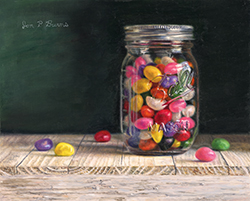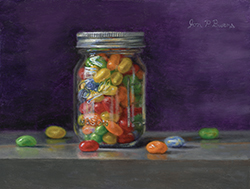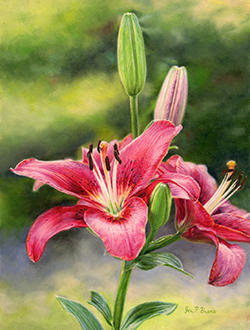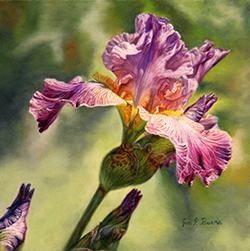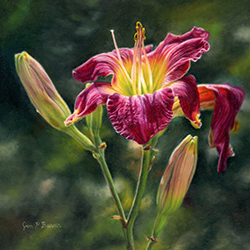| AVAILABLE WORKS | ||||||
BIOGRAPHY - Jon Burns (Born 1975)
Jon Burns grew up in Cottage Grove, Minnesota on the eastern bank of the Mississippi River. just south of St. Paul. His father was a quality engineer for Sperry-Univac Corporation and his mother worked part-time at their church, often serving as the catering manager for parish events. When he was born on August 12, 1975, Cottage Grove was a close-knit community with deep roots in the area. New England settlers had arrived there in the 1840s and for over a century, they governed themselves as a township, following the tradition that was established in their previous hometowns. That changed dramatically in 1974 when Cottage Grove officially became a city; its proximity to St. Paul and Minneapolis made it a prime location for development. Nonetheless, Cottage Grove has been a faithful steward of its heritage, preserving and maintaining an exceptional number of the original buildings from its township days. [i]
Although Burns had no siblings, his childhood was filled with community activities, including participating in a camping club. Unlike the commercial ventures that call themselves camping clubs today, the Burns family belonged to a group of families who simply went camping together, selecting a different location each month. As Burns recalls, there were about twenty children all together in the group. They biked and hiked and swam and of course, learned a variety of outdoor skills in the process. Burns was especially fascinated with the natural world of plants and birds. It was during these years that he began to sketch the plants he saw in the wild. He also credits his mother’s love of birding for his own interest in the activity.
By the time Burns was in middle school, his mother had started her own catering business where he would soon find himself working. Drawing would continue to be a pastime, but once he started high school, Burns signed up for art classes. He was fortunate to have an encouraging art teacher in Raymond Lundgren, who challenged him to participate in school art events. In particular, Lundgren urged Burns to submit his artwork to the “Best 100 Art Students” competition for high school students. The reward was being included in an art exhibition at Macalester College in St. Paul. Not surprisingly, Burns won the competition and the chance to display his work to a much larger audience in the Twin Cities. This experience also underscored the possibility that Burns’ might want to consider a career as an artist.
It was Burns’ fascination with plants and the natural world that steered him in a different direction when he went to work as a seasonal employee of Bailey Nurseries during his high school years. Located in Newport, Minnesota, the nurseries were not far from his home in Cottage Grove. Bailey Nurseries began as a retail garden center in 1905 and became a wholesale business in 1956. By the time that Burns worked there, it was a national producer of outdoor landscape plants including trees, shrubs, and perennials, with a special focus on rose breeding. [ii]
Burns’ dedication to his work at Bailey eventually led to a scholarship at the University of Wisconsin-River Falls, sponsored by the company. There, he enrolled in the horticulture and landscape design program where he could expand his study of botany. Looking back, he notes that it was in his landscape courses that he was introduced to the formal principles of design, such as composition, color, shape, and texture. His college years were shadowed by the death of his mother, but he was able to complete his degree program and return to full-time work at Bailey. Sadly, his father died just a year after Burns’ graduation.
By the turn of the millennium, Burns had become a skilled horticulturist. His initial job after completing his degree was working with the propagation of new varieties of roses as well as trees and shrubs, contributing to the impressive volume of roses that was then being sold through Bailey Nurseries. [iii] He was soon coordinating the propagation work during the summer seasons and supervising a staff of 50 employees. Eventually, that would lead to Burns’ involvement in the development of new cultivars. In fact, he is responsible for the creation of a button bush cultivar named “Fiber Optics”. [iv]
Burns’ horticultural work was both challenging and absorbing, but he was increasingly considering a return to the study of drawing. In 2007, he enrolled in a class at The Atelier, an art school in Minneapolis that offers a classical curriculum based on the Ecole des Beaux-Arts in Paris. At first, it was a part-time activity, something he could study during the down seasons in the nursery business. He generally focused on still life and figure drawing, which reflected his life-long interest in the natural world and was also clearly related to his work in horticulture.
The Atelier classes opened a new chapter for Burns. Not only was it a place where he could study traditional drawing and painting, but it also grounded him in a curriculum that traces its lineage back to the French neoclassical painter, Jacques-Louis David (1748-1825). Very few American art schools offer such a classical program. [v] For three years, Burns studied part-time while working at Bailey Nurseries, but in 2009, he decided it was time to embrace his art as a career. He continued to work at Bailey until 2011, when he finally resigned and plunged whole-heartedly into a concentrated study program: five days a week drawing from models or still life vignettes in the studio each morning followed by an afternoon of “brush time” in one of the small studios at The Atelier. His goal was to master the techniques of what is today called classical realism.
Burns’ study at The Atelier introduced him to the nineteenth masters of the academic tradition. Jean-Léon Gérôme (1824-1904) was a strong influence on his work during his senior year in particular. The American painter Albert Bierstadt (1830-1902) exemplified the grandeur of uniquely American landscapes, painted with a keen awareness of light and shadow. Although these two artists are very different in their approach to subject matter, their understanding of classical technique is quite similar, both of them focusing on precise compositional strategies and an appreciation of dramatic effect. Among contemporary artists, Burns notes that he was fascinated by the work of wildlife artist Terry Isaac (1958-2019) who often combined botanical and wildlife imagery in his paintings. Both the subject matter and his use of light provided inspiration for some of Burns’ own “bird botanical” imagery. In addition, Burns admires the still-life paintings of the classical realist painter Jeffrey T. Larson (b. 1962), whose use of color and value is especially notable. Like Burns, Larson is a graduate of The Atelier. [viii]
Simultaneously, Burns focused on exhibition options in the Twin Cities, beginning with the student shows at The Atelier and then expanding to the Fine Arts Exhibition at the Minnesota State Fair. It should be noted that the State Fair is a cherished tradition in Minnesota, with an approximately 2 million people visiting it annually. [vi] Burns would exhibit there for four years, building his name recognition and his reputation as an artist. He also exhibited at Art-a-Whirl, the annual open studio tour in the thriving arts district of northeast Minneapolis. This event is centered in a renovated Northrup-King warehouse although there are a number of other venues throughout the district as well. For an artist in the early stages of his career, Art-a-Whirl offers the advantage of attracting an audience that is already curious about visual arts, and open to a variety of styles, media, and content. Typically, there are over 1300 artists participating at 100 sites. [vii]
In 2015, Burns ventured beyond the boundaries of the upper Midwest and submitted a painting to the annual competition sponsored by the Art Renewal Center (ARC), an online museum devoted to academic realist art. The ARC sponsors an annual Salon that features an exhibition of selected works from the competition. Burns’ painting was accepted in the “still life” category. This marked his debut on a national stage and publicized his work to a well-defined clientele. Four years later, his work would also be included in the Fall International exhibition sponsored by the National Oil & Acrylic Painters’ Society.
Burns’ career was interrupted in 2020 because of health problems, but he has now resumed work as a full-time artist and is glad to be moving forward once again. Back in Cottage Grove, he continues to expand his artistic horizons through workshops in plein air painting and several classes at the Minnesota School of Botanical Art, where he has studied English watercolor techniques. He mentions being able to do some traveling again soon “to see the beautiful land and explore art in some of the world’s great museums.” And after that, maybe buy a place in the country where he can build a big studio surrounded by nature.
Janet Whitmore, Ph.D.
Notes
[i] For more information about the history of Cottage Grove, see the Washington Country Historical Society, “Cottage Grove, MN’ at: http://wchsmn.org/research/communities/cottage_grove/index.php.
[ii] For a short history of Bailey Nurseries, see the University of Minnesota Library’s online exhibition, Seed Stories, Catalogue of Life and Gardens in America, “Bailey Nurseries, Inc., Newport, MN”, at: https://gallery.lib.umn.edu/exhibits/show/seedstories/mn-own/baileynurseries.
[iii] Ibid. By 2003, Bailey’s was selling more than 800,000 roses per year as a wholesaler as well as regularly breeding new hybrids.
[iv] For a look at Burns’ Fiber Optics cultivar of the button bush (cephalanthus occidentalis), see: https://www.youtube.com/watch?v+Yb_BaDWNO2U
[v] The Atelier was founded in 1969 by Richard Lack in Minneapolis. The curriculum is based on the training provided at the Ecole des Beaux-Arts in Paris in the nineteenth century. Students learn first to draw and then to paint using traditional techniques. See: https://theatelier.org
[vi] The Minnesota State Fair has long been THE event that marks the end of summer in the state. Unlike many other state fairs, it has flourished and grown over the years, the sole exception being during the COVID-19 pandemic. For information about the attendance at the fair in the 21st century, see: https://www.mnstatefair.org/about-the-fair/attendance/
[vii] Art-a-Whirl is sponsored and managed by an artists’ collective, the Northeast Minneapolis Arts Association (NEMAA). It lasts for three days, usually over a weekend in late May. In addition to visual arts, there are performances and various demonstrations. For more information, see: https://nemaa.org/art-a-whirl/faq/
[viii] Jeffrey T. Larson is the co-founder of the Great Lakes Academy of Fine Art in Duluth, Minnesota. It is part of the loose consortium of classical art schools whose curriculum is approved by the Art Renewal Center.
Shows
2020 Art Renewal Center/Rehs Contemporary Galleries, Taking Flight, New York, NY
2020 Minnesota State Fair, Fine Arts Exhibition, St. Paul, MN
2020 Studio Pintura, Art–a-Whirl 2020, Northrup King Building, Minneapolis, MN
2019 National Oil & Acrylic Painters’ Society (NOAPS), Fall International, Online show
2019 Northeast Minneapolis Arts Association, Art-a-Whirl 2019, Northrup King Building,
Minneapolis, MN
2019 Studio Pintura, Bon Appetit competition, Minneapolis, MN
2018 Studio Pintura, Floral Art annual salon, Minneapolis, MN
2018 Northeast Minneapolis Arts Association, Art-a-Whirl 2018, Northrup King Building,
Minneapolis, MN
2018 Art-Attack, Northrup King Building, Minneapolis, MN
2017 Northeast Minneapolis Arts Association, Art-a-Whirl 2017 Northrup King Building,
Minneapolis, MN
2017 Art-Attack, Northrup King Building, Minneapolis, MN
2015 Art Renewal Center, Salon, (Finalist in Still Life category), New York, NY
2015 Hastings Art Center, Minnesota Realists, Hastings, MN.
2014 Minnesota State Fair, Fine Arts Exhibition, St. Paul, MN
2013 Northeast Minneapolis Arts Association, Art-a-Whirl 2013 Northrup King Building,
Minneapolis, MN
2013 Minnesota State Fair, Fine Arts Exhibition, St. Paul, MN
2013 The Atelier, Student Show, Minneapolis, MN
2012 Northeast Minneapolis Arts Association, Art-a-Whirl 2012 Northrup King Building,
Minneapolis, MN
2012 Minnesota State Fair, Fine Arts Exhibition, St. Paul, MN
2012 The Atelier, Student Show, Minneapolis, MN
2011 Northeast Minneapolis Arts Association, Art-a-Whirl 2011 Northrup King Building,
Minneapolis, MN
2011 Minnesota State Fair, Fine Arts Exhibition, St. Paul, MN
2011 The Atelier, Student Show, Minneapolis, MN
2011 Northeast Minneapolis Arts Association, Art-a-Whirl 2012 Northrup King Building,
Minneapolis, MN
2010 The Atelier, Student Show, Minneapolis, MN
Awards
2019 Art Renewal Center/Rehs Contemporary Galleries, Inc.

